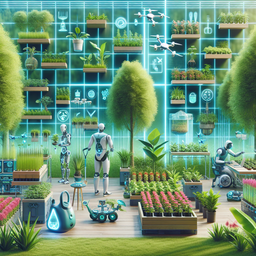I. Introduction to Gardening Climate Zones
Gardening climate zones play a vital role in determining the success of plant growth. These zones provide essential information on the specific environmental conditions, such as temperature and precipitation, that are conducive to various plant species. Understanding and working within the parameters of climate zones are fundamental to creating thriving gardens.
Overview of Gardening Climate Zones
According to Susan Littlefield, a horticulturist at the University of California, 'Climate zones help gardeners choose plants that are more likely to thrive in their specific area. It's like having a roadmap to successful gardening.'
Importance of Understanding Climate Zones for Successful Gardening
Gardening in an unsuitable climate zone can lead to plant stress, poor growth, and ultimately, failure to thrive. By aligning plant choices with the appropriate climate zone, gardeners can optimize their chances of success and create vibrant, healthy landscapes.
II. Understanding the USDA Plant Hardiness Zone Map
The USDA Plant Hardiness Zone Map is a valuable tool for gardeners to identify the climatic conditions of their region and select plants that are best suited to that environment.
Explanation of the USDA Plant Hardiness Zone Map
The USDA map divides North America into 13 zones based on average annual minimum winter temperatures. Each zone represents a 10-degree Fahrenheit difference in average minimum temperature. For example, Zone 1 has an average minimum temperature of -60 to -50 degrees Fahrenheit, while Zone 13 ranges from 60 to 70 degrees Fahrenheit.
Factors Considered in Determining Plant Hardiness Zones
Various factors, including elevation, proximity to large bodies of water, and urban heat islands, can influence local microclimates and impact plant hardiness zones. It is essential for gardeners to consider these factors when determining the suitability of plant species for their location.
Case Study: Impact of Plant Hardiness Zones on Crop Selection
In regions with short growing seasons and cold winters, such as Zone 3, gardeners must select cold-hardy crops like kale, carrots, and Brussels sprouts. Understanding the plant hardiness zone is crucial for successful cultivation and harvest of crops.
III. Identifying Microclimates in Your Garden
Microclimates are localized areas within a garden that have distinct climate conditions, such as temperature, light, and humidity, different from the surrounding environment.
Definition of Microclimates
Dr. Emily Roberts, a botanist specializing in plant ecology, explains, 'Microclimates can create opportunities for growing plant species that may not thrive in the overall climate zone. By harnessing these micro-environments, gardeners can expand their plant selection and enhance biodiversity in their gardens.'
How Microclimates Influence Plant Growth
Sheltered areas near buildings or fences may create warmer microclimates that support heat-loving plants, while low-lying spots may experience frost pockets, affecting plant selection. Understanding these nuances can help gardeners make informed decisions about plant placement.
Expert Insight on Utilizing Microclimates for Gardening Success
According to Dr. Michael Wong, a renowned horticulturalist, 'By strategically planting sensitive species in microclimates that mimic their native habitats, gardeners can optimize plant performance and increase overall garden resilience.'
IV. Adapting Garden Practices to Specific Climate Zones
Tailoring garden practices to match the conditions of different climate zones is crucial for successful gardening outcomes.
Best Practices for Gardening in Specific Zones
Watering schedules, mulching, plant selection, and other cultural practices should be adjusted according to the needs of plants in specific climate zones. For instance, in arid regions, drip irrigation and drought-tolerant plants are essential for water conservation.
Case Study: Successful Gardening Practices in Challenging Climate Zones
In desert regions like Zone 10, gardeners have achieved thriving landscapes by incorporating succulents, cacti, and other drought-resistant plants. By embracing the unique characteristics of their climate zone, these gardeners have created sustainable and visually appealing gardens.
V. Climate Change and Its Impact on Gardening
Climate change poses significant challenges for gardeners as shifting weather patterns and unpredictable climatic conditions can disrupt established gardening practices.
Overview of Climate Change Effects on Gardening
The increasing frequency of extreme weather events, altered precipitation patterns, and rising temperatures all have profound implications for plant growth and garden maintenance. To adapt to these changes, gardeners need to be proactive and resilient.
Strategies for Adapting to Changing Climate Conditions
Implementing water-saving techniques, selecting heat-tolerant plant varieties, and utilizing sustainable gardening practices are essential strategies for mitigating the effects of climate change on gardens. Building healthy soil and promoting biodiversity can also enhance garden resilience.
Expert Advice on Preparing Gardens for Climate Change
Dr. Jane Sanchez, a climate scientist specializing in agriculture, highlights the importance of monitoring local climate trends and experimenting with new plant species that may be better suited to future conditions. 'Gardeners should view climate change as an opportunity to explore innovative gardening techniques and embrace resilient plant species,' says Dr. Sanchez.
VI. Conclusion
In conclusion, navigating gardening climate zones and microclimates is essential for achieving successful plant growth and garden sustainability. By understanding the USDA Plant Hardiness Zone Map, leveraging microclimates, adapting garden practices to specific zones, and preparing for climate change impacts, gardeners can cultivate thriving and resilient landscapes.
Call to Action
Gardeners are encouraged to explore local climate resources, engage in community gardening initiatives, and share their experiences and knowledge to foster a collaborative approach to gardening in an era of changing climate conditions. Continuous learning and adaptation are key to optimizing garden success in an ever-evolving environment.
Topics




